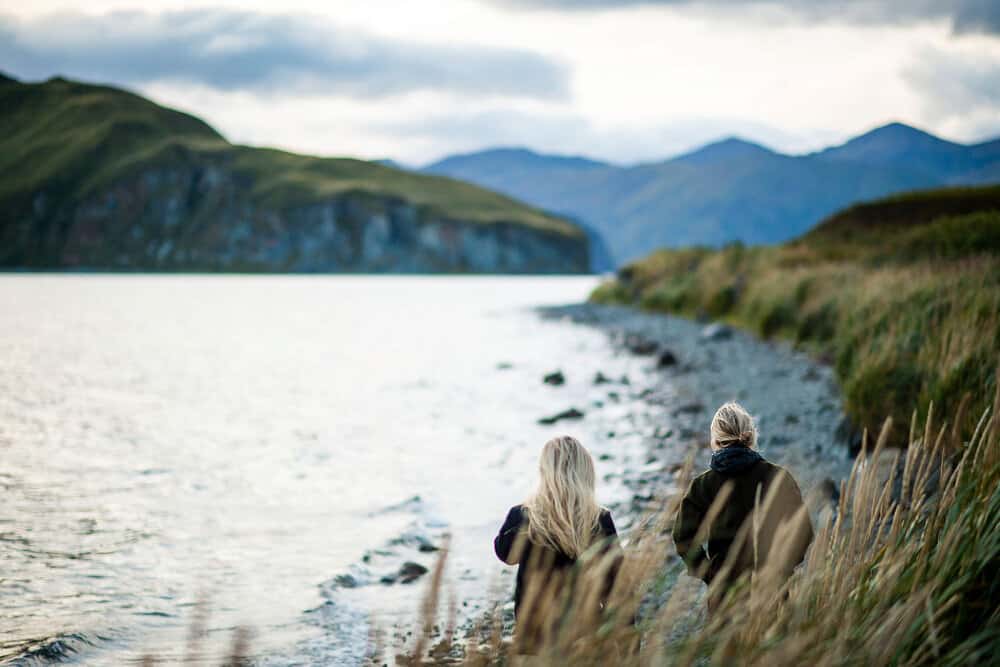Your cart is empty
WORDS BY Emma Teal Laukitis
PHOTOS BY Dawn Heumann
ALEUTIAN ARCHIPELAGO | ALASKA
Spanning the North Pacific in a 1,200-mile arc of windswept islands, smoking volcanoes, rocky shores and treacherous seas, the Aleutian Archipelago is one of the most dramatic landscapes on earth. For at least 10,000 years, the Aleut — Unangan in their own language — have been the masters of this landscape. Our family made it home, too.
The remote communities of the Aleutians are only accessible by fishing boat or bush plane. The M/V Tustumena, Alaska’s weathered state ferry, makes the long journey west out of the “Chain” once a month in summer months and less frequently in winter. Known to villagers as the “Trusty Tusty,” the beloved ship brings villagers groceries, tools, pets, cars, four-wheelers, kids, visiting doctors, school teachers, Christmas trees, fishing and hunting gear, cans of paint, and building materials from the city.
FINDING STONEWALL
Our dad first ventured west on a fishing boat in 1988, and spent his first summer salmon fishing around Unimak Island while our mom worked at an inn in Glacier Bay. They had met in Seattle and come to Alaska to start a life together. At the end of his first fishing season, he heard about a man named Chuck in False Pass who was looking to sell his alternative energy homestead.
The place was a 20-minute sea journey across the narrow tidal pass from the small village, so Dad caught a ride on a passing boat to find him. He spent a week at Stonewall Place, and in that time, Chuck taught him how the water wheel operated from falling water piped down from the green hills. He taught him how to check and clear the screens of the dams at the water source, and how living this remotely required a bulk food system with mail-order catalogues, five-gallon buckets, a root cellar on the beach, a subterranean refrigerator room kept cool by the earth, a prolific greenhouse, wild foraging, and fishing from the beach and skiff. He also showed our dad how to minimize and utilize waste with a burn barrel, compost with kelp from the beach for greenhouse soil, and pack the rest across the pass in the skiff for disposal in town. Dad learned where to find the biggest driftwood logs on nearby beaches, and how to roll them down into the water with pike poles and tie them up with long lines to tow home behind the skiff, and then chainsaw into firewood for the wood stove.
Perhaps it was the ship’s mast, the porthole windows, or the wall of bottles and jars full of bulk spices and grains in the kitchen that conjured a vision of what life could feel like there. Maybe it was the wood shop equipped with a library of tools that had helped Chuck construct the house and its surrounding buildings. Maybe it was the collection of Vivaldi, Indian pan pipe, songs of the humpback whale, and Pete Seeger records. Perhaps it was the greenhouse overgrown with geraniums, snap peas, beets, and rhubarb, or the smell of warm cedar in the woodshed and the sauna, or the plump salmonberries filling the ravines that summoned a vision of what life could be like here. Whatever it was that drew him in deepest, Dad returned to marry our mom in Gustavus at the end of the summer, and the next year they moved to Stonewall Place.
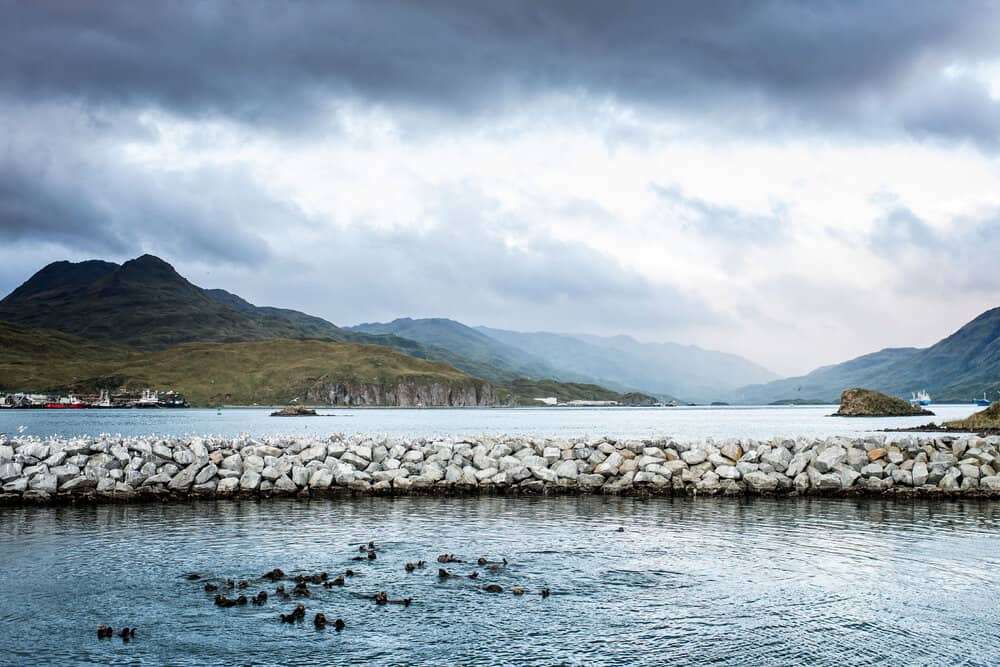
LIFE IN THE ALEUTIANS
Stonewall Place is the westernmost home on the Alaskan Peninsula, built on the tip of the mainland with a sweeping view of the volcanoes on Unimak Island — Raggedy Jack, Round Top, and Shishaldin. Without neighbors on the mainland side of the pass, the closest people live in the small village of False Pass — population 50 — and they are mostly Unangan families and fishermen. At one time, as many as 20,000 people lived in the Aleutian Islands, representing a successful maritime culture. Today, 12,000 of their descendants live and work on the land of their ancestors who migrated across the Bering Land Bridge during the last Ice Age.
Before the arrival of Russians, the Unangan people lived a subsistence, hunter-gatherer lifestyle. They traditionally hunted sea otters, sea lions, whales and seals from one-man and two-man animal skin and whale bone boats called iqayax. On land, they gathered mollusks, birds, fish and wild berries. They made subterranean, half-buried homes with whalebone rafters covered with grass and earth for insulation. Their skills in boat design, art, sea mammal hunting, medicine, woodworking and sewing have seldom been matched anywhere in the north.
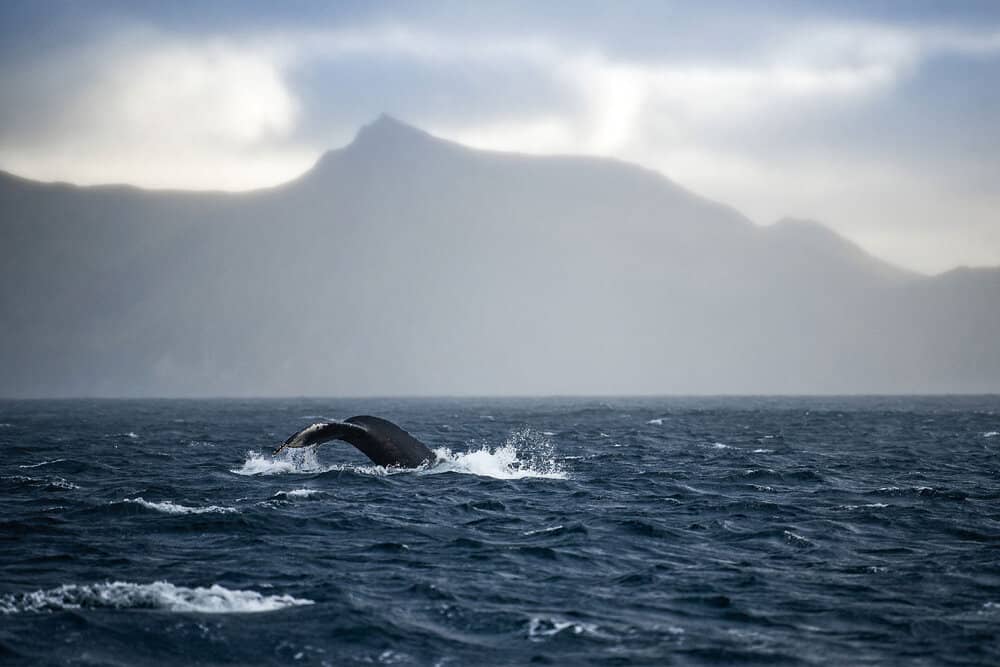
The Unangan people first encountered Russians in 1741, when an expedition led by Vitus Bering reached the islands. The Russians established control over the Aleut villages, and they exploited the skills of indigenous hunters to collect sea otter pelts. At the end of the 18th century, the Russian Orthodox Church sent missionaries across Siberia and into Alaska, and soon Unangans were being baptized into the church. Russian Orthodoxy quickly became the dominant religion in the region. Missionaries brought with them protection from fur traders, as well as vaccinations and literacy.
In 1942, the Japanese Army invaded the islands of Attu and Kiska after bombing Dutch Harbor on Unalaska Island, and occupied the two tiny islands on the westernmost tip of the Aleutian archipelago for 13 months. During World War II, villagers from the Aleutian Islands were evacuated and interned in Southeast Alaska, where they endured considerable hardship.
Today, Russian influence remains: their language peppers Unangan vocabulary, Russian dishes are served in Unangan homes, and Orthodox churches shape the landscape of many villages. Since the passage of the Alaska Native Claims Settlement Act in 1971 — which transferred land claims from the federal government to Alaska Native corporations — regional and village corporations have reestablished guardianship over local land and communities. Unangan communities have worked hard to preserve traditions and cultural heritage, to continue fishing, and to live a subsistence lifestyle.
When our parents moved to the Aleutians, they had a lot to learn from its people and from the land that sustained them. Life in this country revolves around the seasons that drive both the life cycle and the harvest of plants and animals. With spring and summer came wild blueberries and salmonberries, wild celery called putchki, sorrel, boletus mushrooms, butter clams, and blue mussels on the shore, and octopus, trout, and most importantly salmon in the sea. Fall and winter brought caribou into the hills, ptarmigan, king crab, sea urchins, halibut and cod. To live here meant to be part of the life cycle. This meant fishing through the summer, storing your catch for winter, and hunting during the fall. They traded game for halibut, jars of jam, or smoked salmon. In summertime, their hair grew soft and their skin smooth from the endless meals of wild salmon. In wintertime, their bodies stayed strong as they carried armfuls of firewood through the wind and snow.
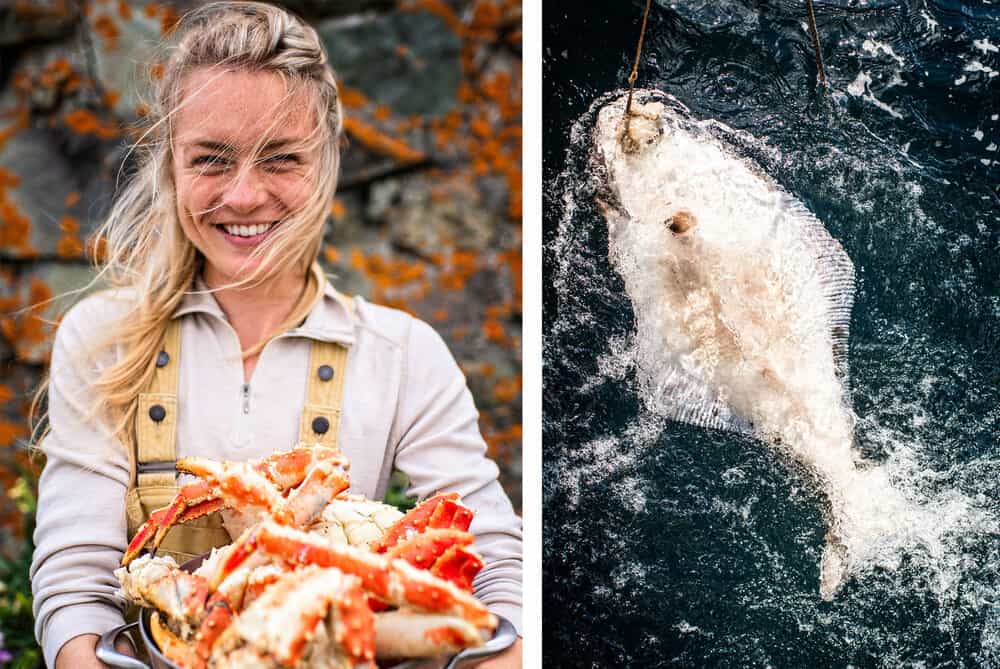
Aleutian weather is known to be ferocious, with wind gusts well over 100 knots and waves three stories high tossing crab boats like toys. Currents rip and heavy fog sits unmoving for days. Those who have spent time in the Aleutians have been humbled by the pure power of a gale, worn down by the wind just as the hills have: treeless, smooth and round. They have experienced powerlessness against mother nature.
“To live here means to look into the face of the wildness of the Earth, to have a bodily understanding of what humans can withstand, to know the line between safety and stupidity, and to recognize that weather connects us intimately to a place, whether fair or full of fury.”
CHILDHOOD HOMESTEAD
My sister Claire was born the summer our parents moved to Stonewall Place, and I was born on the first day of the June salmon season, 13 months later. Our dad bought his first boat and a permit to set net in a neighboring bay, and we grew up between the boat and the homestead. Though we spent a lot of our time on the boat, we weren’t strong enough to pull in nets or lift heavy fish until we were teenagers. Thus, we spent our early years at Stonewall Place, planting seeds in the garden beds, gathering eggs from the chicken coop, and helping our mom smoke salmon.
Life was full there, and the days were kept busy with continual upkeep of the buildings on our property. The weather was hard on the place. We sanded, painted, hauled shingles and sheets of tin roofing up tundra trails, dug holes in the ground for new foundations, and replaced windows blown out by storms and wood rotting in the steamy greenhouse.
Fishing and working on the shore took up much of our time. We set a subsistence net on our beach, where we caught sockeyes to fillet and freeze for winter or smoke and preserve in jars. Our mom learned the art of smoking salmon from an Unangan friend in the village, a process that required a stretch of dry weather, salt and smoke. We picked salmon from the net out of our kayak and carried them down the beach to our fish-cleaning table, set up with a freshwater hose, sharp knives, clean buckets and baskets, and bags of coarse salt and brown sugar for brining. We stripped each salmon fillet into long ribbons of red flesh and tied them in pairs with twine to hang over the long rafters in our elevated smokehouse. Being kept 10 feet above the ground allowed our food to remain out of reach from brown bears, foxes and other animals wandering down the beach. A chimney stack drew smoke into the smokehouse from a barrel stove below, and we stoked the stove with soaked cottonwood logs we had found washed up on the beach. These gave the most flavor.
Our mom, who grew up on a small farm near Seattle, had never so much as caught a salmon before moving to Stonewall. With two babies in cloth diapers, a man falling in love with the sea, and a home on what must have seemed the edge of the Earth, she began motherhood and marriage by teaching herself a new and wild definition of life. Though I don’t remember the years before her mastery of this life, I can imagine now — as I’m the same age as she was then — how unfamiliar it must have felt to be there without her family and friends, to have two infants without a hospital or phone accessible to her, and for home to be in a land wild with bears, eagles, and a dangerous sea.
Yet, our mom rooted herself deeply into the Aleutian landscape and soaked up lessons for a meaningful life to pass on to my sister and me. What I remember most from our childhood at Stonewall is the time we spent with her while our dad was at sea during the fishing season, and the things she taught us there. We packed smoked salmon and watercolor sets in our backpacks and hiked through the wild primroses, lupine and geraniums to sit in the tundra and paint the flowers in our sketchbooks. We picked bouquets and brought them home to press in the Encyclopedia Britannica set Chuck had left on our bookshelf. We took to the hills with berry buckets and spent hours in the blueberry bushes, with purple fingers and mosquito bites, talking about the jam and pies we would make later, the books we were reading, and the fish Papa was catching. We wrote letters to our grandparents, we read aloud in the living room rocking chair — stories of Greek mythology, C.S. Lewis, Louisa May Alcott and Harry Potter. We learned to play songs on the recorder, to knit and crochet, and to use tools in the workshop to build wooden boats and race them down our creek.
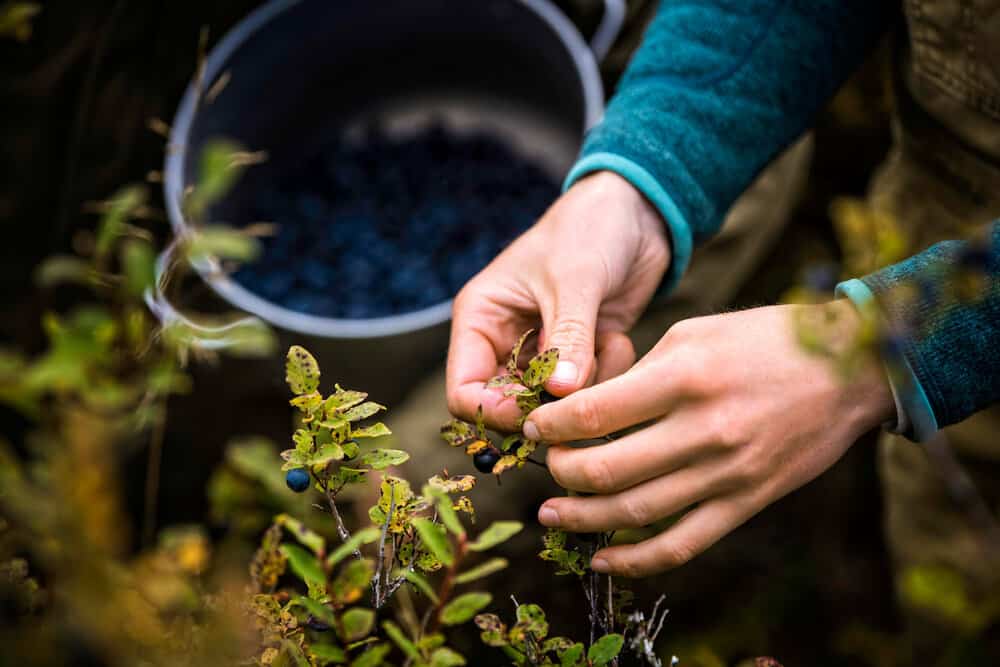
Mom sewed upstairs in our small A-frame house on days when the weather was stormy. She had a Singer and a serger machine, and she made warm fleece jackets and pants for fishermen to wear under their raingear. She taught us to sew on the machines and by hand, and we spent hours making clothes for our dolls and stuffed animals with her fabric scraps. For Christmas gifts, we made our relatives in Washington and Illinois t-shirts printed with a yelloweye rockfish our dad brought home from sea. Our mom showed us how to plant potatoes with a herring in the ground for fertilizer, how to grow sprouts in the kitchen for fresh greens during the winter, how to make yogurt and use sourdough, how to pressure cook jars of jam and salmon, and how to dehydrate halibut into jerky.
Our mom’s rhubarb custard pies were so famously good that fishermen began dropping anchor in front of our house and offering king crab as payment. Her love for sharing good food with people has always been an important part of our home. With the best fresh ingredients from the land and sea in hand, life felt full, and a feeling of richness surrounded us, no matter how the fishing season went.
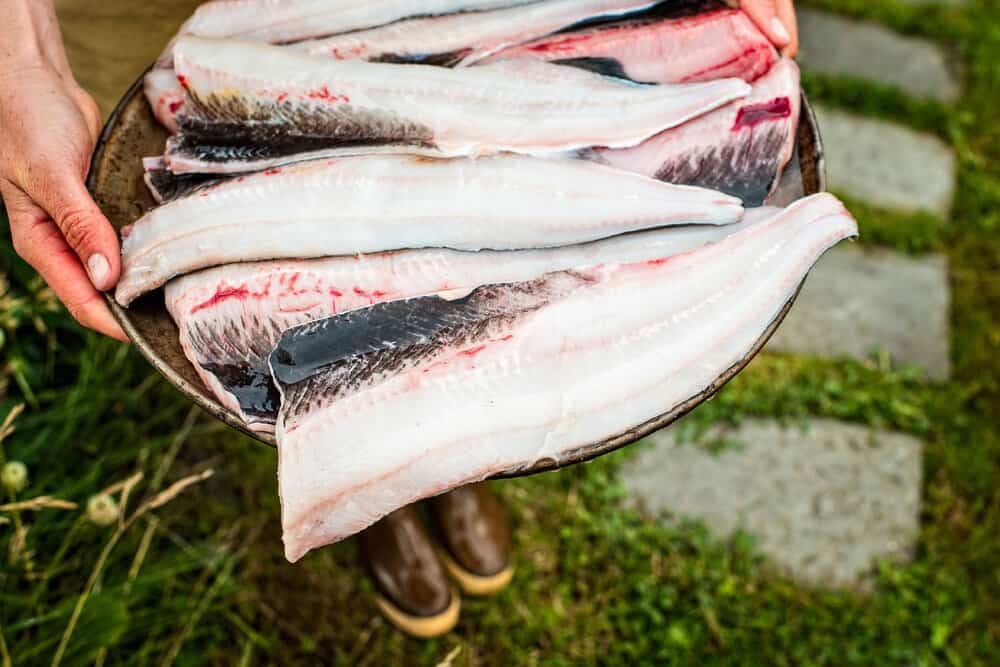
BECOMING THE SALMON SISTERS
In Alaska’s near-constant summertime daylight, fishermen often angle for 20 hours a day. Early in the morning, they look for fish, set the net as the sun is still rising, and brew a pot of coffee. The rest of the day is a repetition: set the net, pick the net, repeat. Meals, sleep, and boat maintenance are thrown into the rhythm of the day, but the work is nonstop through the summer.
As we grew older and stronger, we began working those summer rhythms on the water with our dad. We were at sea with him for weeks at a time. Our bodies adjusted to the movement of the waves and long days picking salmon from the net or baiting halibut hooks, taking wheel watch, and feeling for the first time both exhausted and fulfilled by life as fishermen.
We learned to cook on the boat with pots sliding back and forth over the stovetop. We learned the dance of living together in our small boat cabin — sleeping in bunks stacked atop one another in the bow, stowing our few belongings securely so they wouldn’t roll about the cabin in a swell, rotating who sat and who stood, who used the sink to brush their teeth or wash their hands or do the dishes. We learned to work together to lift a heavy anchor, tie up the boat, run the hydraulics, and scrub the holds after we delivered our fish to the processor. We endured seasickness and churning waves together. We were scared together and joyful together, dreamed aloud together, and we inspired each other to work hard and stay optimistic even when conditions were tough.
Through high school, we continued fishing during the summers to make money for college. During college, we continued fishing because the sea called us home from the East Coast. After college, the realization began to sink in that fishing was not just a means for making money but part of an identity that would pull us back to Alaska with magnetism.
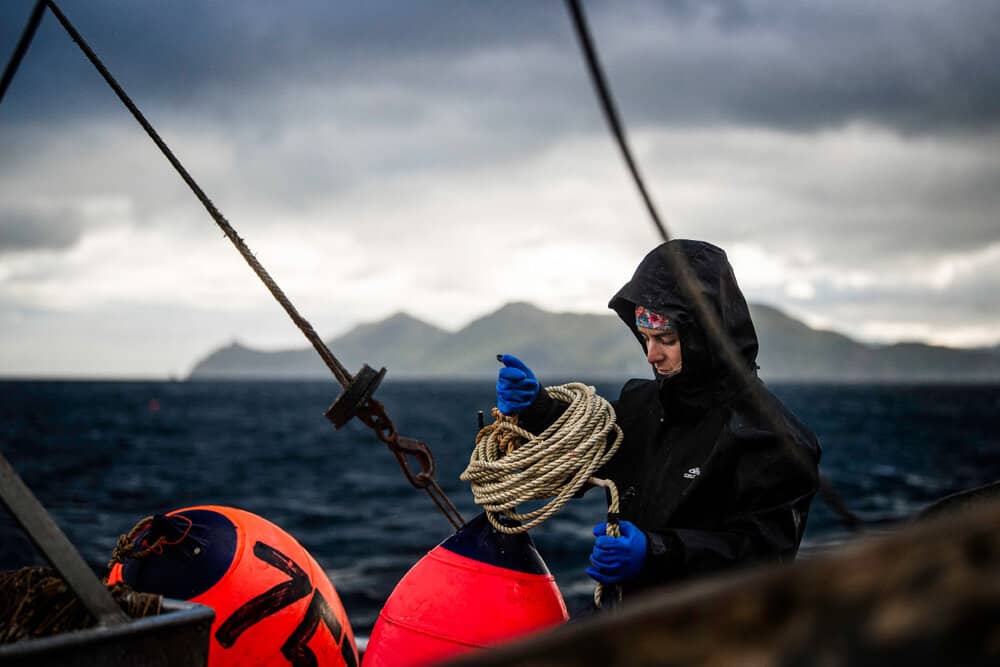
STEWARDS OF THE SEA
Fishing is honest work — the more effort, the more reward. The best fishermen have put their time in, hit rock bottom, and found their way back to the top. They are wise because the sea has taught them many hard lessons. They are respected because they work harder than anyone else. They are respectful of the ocean and consider themselves stewards of the natural resources they depend on. Their lives, their families’ lives, and their communities’ lives all depend on the health of the ocean and its creatures.
Fishing also allows a unique freedom and independence that is difficult to find in other occupations. The risks are high, but the rewards are high too. A fisherman must keep their boat running and their crew safe, because it’s their responsibility and theirs alone. A fisherman is free to wake up whenever they want, call their own shots, decide where to set their net, fish for two hours a day or twenty, when conditions are rough or calm, go to shore each night or stay at sea. Everyone has their own fishing style and operation, and chooses their own path.
The thing I love most about fishing is the way we become a part of our environment. We catch salmon that nourish our bodies and provide for our families, just like the seals in the waves and brown bears on the shore. We share the sea with the busy puffins and stoic albatross, the quiet moon jellyfish, shimmering schools of herring, and huge halibut in deeper waters. Whales and porpoises keep us company as we travel through the rolling green islands and the ocean changes colors with the sky. I often feel the most at peace and fulfilled when I’m fishing, because life is made simple. I catch the food I eat, and it is wild, fresh and nutritious. I am working with my body, and my soul is inspired by the wild places around me to create, dream, and take care of them as they take care of me.
That sense of sustenance goes beyond personal experience. Sustainability was written into Alaska’s state constitution upon statehood, and the Alaska Department of Fish and Game remains responsible for our abundant fisheries. Natural resources are managed for sustainable yield, and this is the underpinning of all other Alaska fishery management regulations and policies. As an example, salmon are managed to achieve species and river-system-specific escapement goals, which means the number of salmon spawning. These goals are based on the carrying capacity of a particular river system and established to maximize the number of salmon returning in future years. Our fishing days our regulated to ensure the escapement goals are met, so we don’t get to fish until enough salmon have returned to their home streams to spawn. When necessary, fisheries are closed or restricted to rebuild weakened fish stocks. While these restrictions limit the amount we can catch, they’re vital for protecting the sustainability of commercial fishing in the state. The future of our livelihood depends on our ability to manage and utilize the abundance of our oceans responsibly, and as fishermen we understand the important role we must play as stewards in this ever-changing environment.

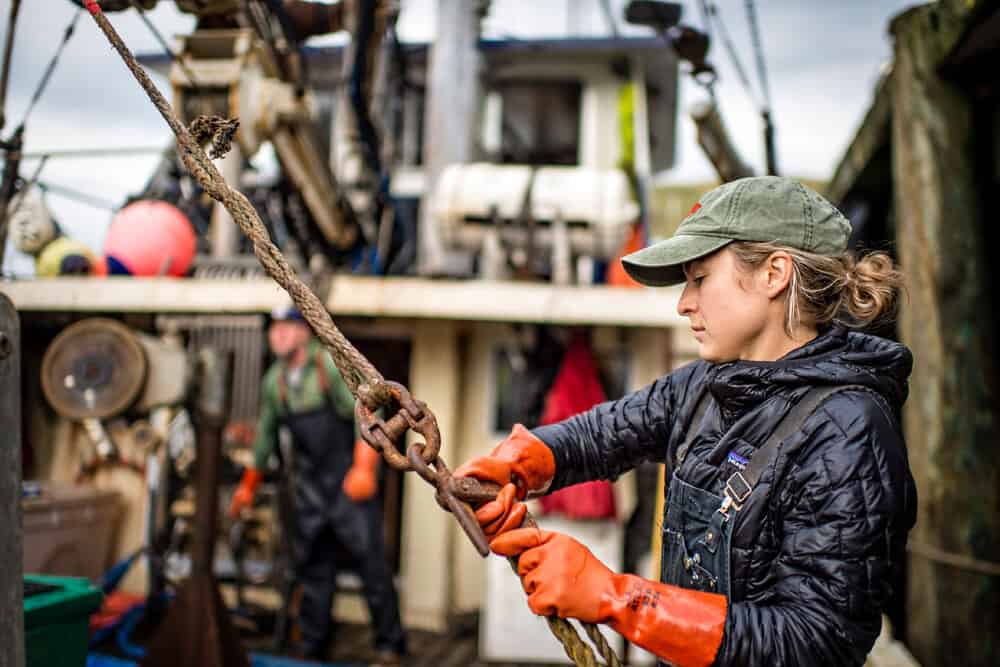
CONTINUING RHYTHMS
This summer, I caught salmon in Alaska as I have every summer of my life. My sister and I, however, were on different boats.
Claire is now married to a fisherman, and by the time this story is published, I will be too. Life still revolves — as it did at Stonewall Place and on our childhood boat — around the ocean and its abundance. Springtime comes, and we prepare for the coming season: mending our nets, hauling groceries down the harbor ramp, adding auto-replies to our emails that say “Gone Fishing,” and stocking up on books, tools, and supplies that will get us through the next 100 days at sea.
When we finally untie from the dock and head out, trade our land legs for sea legs, and remember what it feels like to be out in the remoteness of our fishing grounds with the seabirds and sea lions, we embrace the responsibility our home has handed us. Our reverence for this rich and meaningful life runs strong in our blood, just as the salmon swim wild in an everlasting cycle through Alaska’s oceans, rivers and streams. This life we’ve been given is beautiful and wild.
